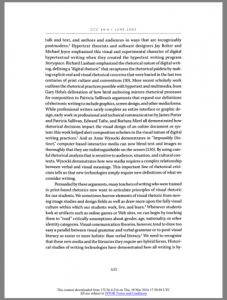The informational article, “Understanding Visual Rhetoric in Digital Environments”, displays the essential visual rhetorical strategies an educator needs to successfully develop a student’s writing skill in digital environments. Hock provides vivid examples, instruction, and description of visual rhetoric in web design. The evidence put forth ensures for each composition educator is able to equip students of writing with style.
This article is not meant to cater to students,as it mostly complies to an opposite audience. The context dwells on subjects familiar to a teaching curriculum. Therefore, the context to the article is more attainable to scholars and professors of composition. Notwithstanding, the principles described throughout the article could act as a stepping stone to improve a pupil’s writing skills, but just harder to obtain. The picture below depicts the monotonous and complexity of the article that would cause a student to have difficultly relating to it.

You must overcome the dull theme and complex vocabulary to digest and come to really understand the message of the text.
Today, the Internet is becoming an extremely useful tool for writers. Writers are able to compel their readers not only through text, but through images and visuals. The breakdown of visual digital rhetoric must contain three components: audience stance, transparency, and hybridity. These strategies ensure that the writer creates ethos, familiarity, and connectivity of visual and verbal design.
